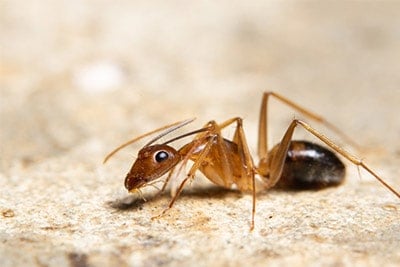Latin Name: Tapinoma Melanocephalum

Ghost ants live in the tropical and subtropical regions of the world. Their name is primarily because of their color and size & they move erratically and rapidly like spiders.
Ghost ants are known to build huge colonies that contain 100 – 1000 workers and queens. They also don’t feed on ant baits. Therefore, they may be difficult to control. One of the most effective approaches to control them is to find the colonies and treat them directly. So, contact us for a free inspection.
Ghost ants with the botanical name, Tapinoma melanocephalum, have a milky or pale abdomen, making it difficult to see. They have dark heads and thoraxes, and their workers are about 1.3 to 2 mm long. The queens are relatively longer (2.5 mm). They do not have wings, and they have two antennae that help their movement. They have three pairs of legs that are almost transparent, which further reinforces their name. They are related to odorous house ants, mainly because of the coconut-like odor they give off when they are crushed.
Ghost ants are in Texas, Florida, Hawaii, and other similar areas in the United States. They are also found in Canada because ghost ants survive in temperate regions and indoor environments. In some parts of the US, you can find them in warm greenhouses and heated buildings. You can also find them in areas close to human settlements, i.e., trees, old branches, moist grass, plant stems, and dry grass clumps. At home, they live in wall cracks, bathrooms, indoor flowerpots, behind baseboards, etc. In addition, you can find their nests beneath carpets and other favorable spaces.
Ghost ants are sweet eaters. Therefore, you will always find them where there is food. Also, because of their high moisture need, you will find them in sinks, shower stalls, and potted plants. They are also most active in the daytime and are very social.
Ghost ants are known to feed on greases and sweets. They love to prey on arthropods. Therefore, the local population of spider mites reduces in areas that have many insects. However, if you find them in wild places, you will see them feeding on both live and dead insects. You will also always find them around aphids and other homopterans because of the honeydew they produce.
When they are indoors, you will find them feeding on sweets in small groups. However, you will never find them chew or eat wood like raspberry crazy ants.
Ghost ants are tiny and can get into your home through several openings around the windows, doors, and foundation. Sometimes, they get into the home accidentally by infested plants. When they are indoors, they feed on sweets like cereal, sugar, and syrup. You will also find them in areas like the bathroom or kitchen counters and sinks.
Ghost ants do not sting or bite unless provoked or threatened. When they do bite, they give a mild painful, non-poisonous bite for resistance or defense. These bites can inflict a slight itching; however, they will never cause any skin reactions.
They also don’t damage furniture or pose a threat to household pets like raspberry crazy ants. However, they can serve as a transferring agent for diseases.
Ghost ants are usually found in multiple nesting sites, especially since their queen is constantly moving about to create new colonies. They are severe pests in greenhouses as they can infest the plants.
Finding ghost ants colonies can be tricky, primarily because of their small size. They can also see in different nests at odd places. However, you will always find the pest wherever there are food crumbs or spills. Another way to detect their presence is their smell. When crushed, it emits an unpleasant and pungent odor similar to rotten coconut.
Although they do not bite or sting, they always create a serious household nuisance and property damage.
Ghost ants can be challenging to control, and sometimes baits don’t do the trick. Hence, the best way to prevent them is to identify the colonies and treat them directly. When you can’t find the colonies, you may attempt baits. However, regular inspection by professionals is your best bet.
If you want to keep ghost ants out, do the following:
